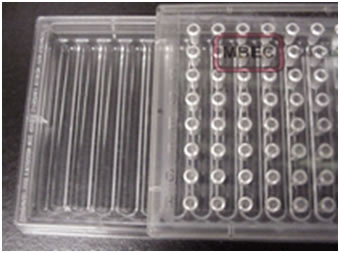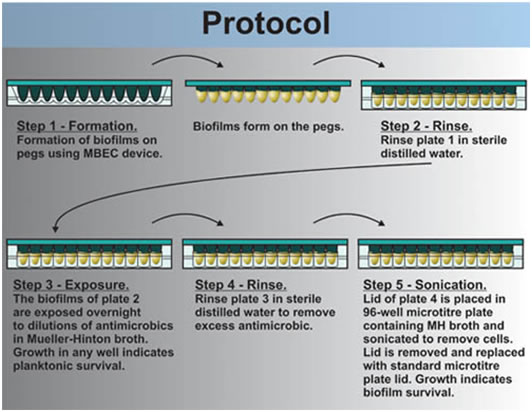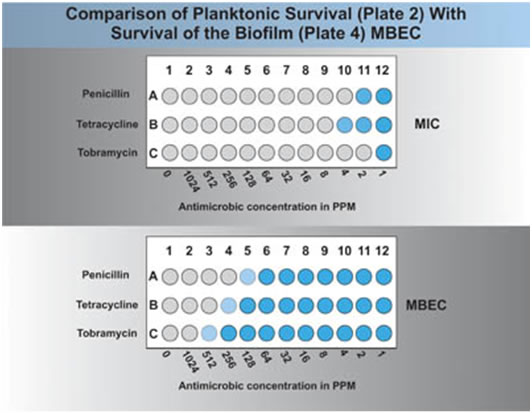Antimicrobial Sensitivity:
Biofilm vs. Planktonic Cells
(Using the MBEC Assay System HTP1)
Student Version (go to Instructor Version)
Introduction
One of the most important properties of biofilms is the increased resistance to antimicrobic** substances, both disinfectants and antibiotics. This resistance has implications for both clinical and industrial microbiology. This exercise illustrates a method for determining the resistance of biofilms to disinfectants and antibiotics and for comparing that resistance to planktonic cells of the same species. The exercise employs the MBEC – Assay System (minimal biofilm eradication concentration), also called the Calgary Biofilm Device and devised at the University of Calgary.
Supplies Needed per Student or Pair of Students
| 1 | Sterile MBEC™ lid and trough. Teachers note: several students or pairs of students can use the same MBEC device, thus reducing the cost of this exercise. |
| 4 | Standard 96 well microtiter plates |
| Mueller Hinton Broth (1/10 normal strength) for preparing stock solutions and antimicrobial note dilutions (sterile) | |
| Tryptic soy broth (sterile) 1/10 normal strength | |
| Samples of disinfectants and antibiotics (sterile) for testing. The number of antibiotic agents that might be used in this exercise is very large and might include penicillin G, amikacin, ampicillin, ciprofloxicin, vancomycin, tetracycline, streptomycin, and tobramycin. Antibiotics with limited water solubility or which are colored (rifampin) should probably be avoided. | |
| Sterile 0.9% saline | |
| Sterile pipettes, 1 ml size | |
| Automatic pipettes adjusted to 200 μl and 100 μl | |
| Sterile pipette tips appropriate for the above | |
| An overnight culture of Pseudomonas putida or other organism on solid medium such as tryptic soy agar. | |
| Gloves (latex, nitrile or equivalent) | |
| Platform rocker (tilt angle approx 9°) set at 10 excursions per minute | |
| Vortex mixer | |
| Sonic waterbath cleaner and small pan | |
| Sonic waterbath cleaner and small pan |

This exercise employs a new tool called the MBEC™ Assay System. This is a sterile plastic tray similar in design to the standard 96 well microtiter plate. The lid of this plate has 96 plastic pins arranged in 8 rows of 12. Unlike the microtiter plate the base of the device does not have 96 individual wells, but instead has 12 channels into which the pins extend. With this design 96 pins can be exposed to a given culture simultaneously. During biofilm growth, the MBEC device is typically placed on a tilt table or rocker set to 10 cycles per minute, so that the culture flows back and forth producing sheer forces that stimulate biofilm formation.
Inoculate the MBEC™ HTP assay. A fresh second sub-culture is used to create an inoculum that matches a 1.0 McFarland Standard. This solution is diluted 1 in 30 with growth medium. 22 ml of the 1 in 30 dilution is added to the trough of the MBEC™-HTP device. The device is placed on a rocking table to assist the formation of biofilms on the polystyrene pegs.
Period 1
Preparation of the culture
- Prepare a suspension of the assigned bacterium by picking a colony or a sweep of several colonies from the surface of the TSA plate and mixing it in 5 ml of 0.9% saline in a sterile tube. Vortex-mix the tube. The suspension should be visibly turbid, comparable to a MacFarland density standard of 1.
- Add 1 ml of this cell suspension to 30 ml of 1/10 strength LB or TSB and vortex.
- Remove the lid of a sterile MBEC device and add 22 ml of the suspension to the bottom of the plate. Replace the lid so that the 96 pins are now suspended in the culture.
- Place the MBEC device on the tilt table (10 excursions per minute, not to exceed 7 degrees from the horizontal) and incubate until the next period.

Period 2
A. Preparing the antibiotic dilution series
- Your instructor has provided samples of antibiotics dissolved in a diluted standard medium called Mueller Hinton broth (MHB). The antibiotic it is prepared at a concentration of 1024 μg/ml.
- You will be assigned a series of 12 wells in a 96 well microtiter plate, for
example Row A 1-12.
- Pipette 200 μl of sterile 1/10 MHB into well 1. This is the zero control well.
- Into well 2, pipette 200 μl of the undiluted antibiotic solution (1024 μg/ml).
- Into wells 3 through 12 pipette 100 μl of 1/10 Mueller Hinton broth without antibiotic.
- Starting with well 3, pipette 100 μl of the undiluted antibiotic solution into the well. Mix the dilution by pipetting it up and down several times. Now, remove 100 μl of the dilution in well 3 and transfer it into well 4.
- Mix the contents of well 4 by pipetting up and down. Transfer 100 μl to well 5. Repeated this process with each succeeding well through well 12. After well 12 is mixed, removed 100 μl of the solution and discard into the container provided.
- Finally add 100 μl of sterile 1/10 strength MH broth to each well from 3 to 12 bringing the final volume in each well to 200 μl.
The final concentrations of the wells are now as follows in each well.
| Well | 1 | 2 | 3 | 4 | 5 | 6 | 7 | 8 | 9 | 10 | 11 | 12 |
|---|---|---|---|---|---|---|---|---|---|---|---|---|
| μg/ml | 0 | 1024 | 512 | 256 | 128 | 64 | 32 | 16 | 8 | 4 | 2 | 1 |
B. Challenging planktonic and biofilm cells with the antimicrobic** agent
- Recover the MBEC plate prepared during the previous period.
- Rinse the pegs of the MBEC lid by immersing the pins into a 96 well plate in which each well contains 250 μl of sterile 0.9% saline (plate 1).
- Lower the lid of the MBEC assay device with its 96 biofilm coated pins into the 96 well microtiter plate prepared above (dilution series). This plate is called the Challenge Plate (plate 2). Each row of twelve wells contains a dilution series of the selected antibiotic. The volume in each well should be adjusted to accommodate the volume of the well (typically 200 μl/well). In any event, the antimicrobic** solutions should completely cover the biofilm on the pins.
- The plates are incubated over night at the optimum temperature for the organisms selected (25 C for P. putida).
- During this overnight incubation, some cells will slough off the biofilm. These cells rapidly revert to their planktonic phenotype. These cells are therefore exposed to the antimicrobic** agent in the planktonic state. Growth, as indicated by turbidity, in any well indicates that the planktonic cells have survived the antimicrobic** treatment. This observation gives the minimal inhibitory concentration (MIC) that has completely inhibited cell growth as indicated by a complete lack of turbidity.
Period 3
- After the 24 hour incubation period, rinse the pins of the MBEC lid by placing it in a 96 well microtiter plate in which each well contains sterile 0.9% saline (250 μl/well) (plate 3). This rinse removes excess antimicrobic** agent. Rinse for 1 minute. This wash plate is then discarded.
- Place the washed CEB lid in a 96 well microtiter plate into which
each well contains 200 μl sterile 1/10 strength MHB or CAMHB with no antimicrobic** (plate 4).
- Remove the biofilm cells from the pegs by sonication. To do this, place plate 4 in a pan floating on the liquid surface of a sonic water bath. Turn on the sonic water bath and sonicate the MBEC lid and 96-well tray on high for 5 minutes.
- Replace the MBEC lid with a standard microtiter plate lid.
- Incubated the plate overnight at the optimum temperature for the organism selected.
Period 4
Growth in any well following incubation indicates that at least some of the cells in the biofilm attached to the pins have survived the antimicrobic** agent. This is the Minimal Biofilm Eradication Concentration (MBEC). Compare the growth in plate 2 with that in plate 4. This should indicate the relative resistance of planktonic and biofilm associated cells. If a plate reader is available this comparison can be made automatically.

Assessment
Is there any difference in resistance between the planktonic cells (plate # 2) and the biofilm cells (plate # 4)?
To what properties of the planktonic and biofilm cells might you attribute any differences observed?
Reference
1 H. Ceri, M.E. Olson, C Stremick, R.R. Read, D. Morck and A. Buret. 1999, The Calgary Biofilm Device: New Technology for Rapid Determination of Antibiotic Susceptibilities of Bacterial Biofilms, Journal of Clinical Microbiology, Vol. 37, pp 1771-1776.
